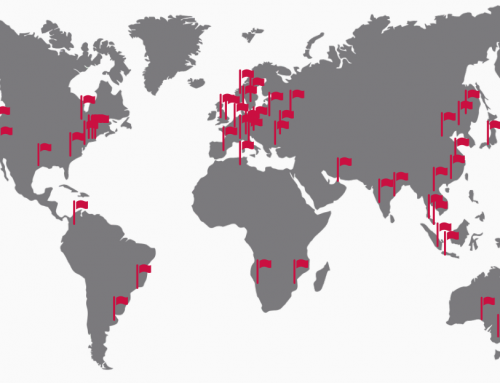Give me a lever long enough and a fulcrum on which to place it, and I shall move the world. – Archimedes

Sometimes a system cannot be developed step-by-step over a series of nudges, because the interdependencies are so strong that the status quo is reinforced. In technical terms: a strong attractor basin. Imagine nudging a billiard ball: In many cases the ball is on a flat billiard table. This is where a nudge works. The impulse pushes the ball as far as the energy lasts. A small impulse equals a short distance, a big impulse a long distance. But imagine the ball lies in a soup plate on the table. As long as the impulse does not suffice to push the ball over the edge of the plate, it will always come back to its original position.
If the stabilising forces of your system act like the soup plate, you cannot nudge the system, you need to yank it. You force it to make a step change.
Max Uehlinger: Schiffslände-Tauzieher, Basel
A telling example happened in my home region of Basel during my teenage years. It was the time of acid rain and forest decline, in the Eighties of the last Century. Already earlier, during the Oil crisis of the Seventies, there were political forces who wanted to decrease personal mobility, especially commutes by car, and shift them to public transport. But the measures at the time, such as a commuter train that went directly to the part of town where the large employers had their headquarters, or the encouragement of carpools, did not outlast the Oil crisis.
Picture a system of public transport. There is a balance between supply and demand. The density of the network, the frequency of buses, trams and trains, the number of late lines, the co-ordination of the timetables of various companies, together constitute the attractiveness of the service. An attractive service may cost much to operate, but since many people use it, tickets and passes can be offered at a competitive price: a balance of supply and demand on a high level. If the service is not so attractive, less people buy tickets, but it also costs less to operate, and we have a balance of supply and demand on a lower level. But on a low level, no single transport company has the financial stamina to ramp up their part of the service and wait until enough people change their habits so that the revenue balances out the cost again. Also, an individual improvement may never have an effect on the whole service. At the same time, every company waits for the others to improve the service, in the hope that the increase in passengers may spill over onto their part of the system, although they had no part in the investments. This is another example of the tragedy of the commons. We have our billiard ball in a soup plate. What is needed to get the system from low to high, is a step change.
In the Eighties, however, the context was different from the Oil crisis. Public opinion was alert on acid rain. This provided a unique window of opportunity for a step change. At the time, our neighbour was the minister of finance of one of the cantons in the region. Together with his colleagues, he pushed forward on several levels at once. They persuaded the parliaments of two cantons to heavily subsidise a monthly pass, directed at commuters. They put pressure on the four transport providers in the region to introduce a common tariff system that would allow for tickets to be valid for rides with different means of transport, and to harmonise their timetables. This was particularly difficult because one of them, the national railways, had to take into account interests and priorities from other regions as well. The local government forced them to introduce late lines, and increase frequency, partly subsidising the effort for a limited number of years. They allowed for special park and ride areas at train stations which served as hubs for remote villages. Only with this initial funding and political pressure could the system be put on a new level of supply and demand balance, on which it continues to operate today.
Another example where systems often need a yank in order to find a new equilibrium is culture. If you gradually change a small minority of people in a group, chances are the culture does not change much. It “eats” the new individuals, and they adapt much more of their own habits, than persevere and change the habits of the existing workforce. Even in a merger, one culture often absorbs the other – and it is not the culture which is best at performing that wins the day, but the culture which is best at surviving in a situation of pressure, insecurity, and negotiations, as is the case in a post merger integration. This was the case at the UBS merger. By comparison, one of the few companies which less than five years after a merger had a new culture of its own was Novartis. And Daniel Vasella, the CEO at the time, clearly told the public how this came about: within five years, more than 70% of senior managers had come from outside the company. A step change to bring the ball out of the soup plate.
Especially in culture development projects I often encounter managers who are not willing to yank their system. For many reasons this can be perfectly sensible. But when the system stability is defined by strong attractor basins, the consequence is not to increase the degree of hope you put in nudges, but to accept that this is a reality you just have to live with.




